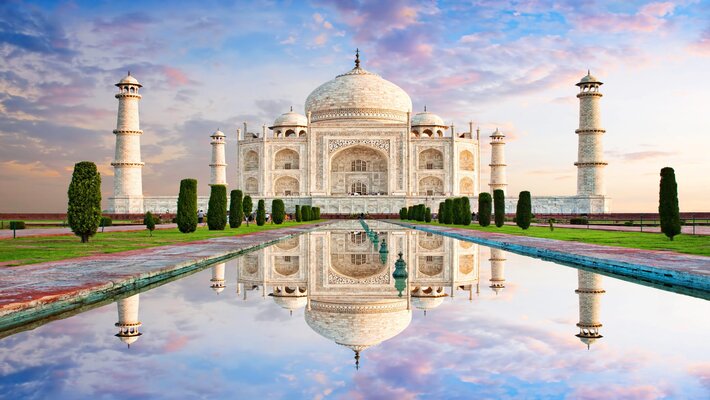
Dating back its early origins in 1193 when the Ghurid dynasty established Delhi as their capital, Indo-Islamic Architecture or Indo-Saracenic architecture marks one of the most unique and important chapters in Indian architecture history. After the Turkish conquest of North India, in the 13th century, Muslims took in different features of the local culture into their own, and owing to that, the Indo-Islamic architecture flourished. The combination of different varieties of decorations in the surface, different styles of shapes, and a myriad of techniques in building structures paved way to many of the Indo-Islamic architecture that we see today.
Some of the other unique features of Indo-Islamic Architecture includes, a) the use of limestone plaster, dressed stone or chunam to case the walls, b) construction of extremely thick walls that was made from rubble masonry, and c) the usage of a wide variety of stones including quartzite, and sandstone to name a few. And in this article, we will look at some of the most distinctive and important examples of Indo-Islam architecture.
Alai Darwaza
Alai Darwaza which is gateway at the southern side of the famous Quwwat-ul-Islam Mosque in Qutb complex situated in Delhi is a brilliant example of the Indo-Islam architecture. This was built by Ala-ud-din Khilji who was the second Khilji Sultan of the Delhi Sultanate in 1311. Although, the ruler planned to construct four gates, only Alai Darwaza was constructed as he passed away in 1316. Built with red sandstone and white marbles, this structure is the first of its kind in India to incorporate Islamic architecture principles both in its decoration as well as its construction. Aside from that, Alai Darwaza also has unique features of Khilji art and that includes intricate patterns and embellishments that are still visible. Also, Alai Darwaza is shaped like a square and has arched entrances. In 1993, Alai Darwaza was recognized as a world heritage site by UNESCO as well.
Makkah Masjid
Built around the 1600s, the Makkah Masjid or the Mecca Masjid of Hyderabad is one of the most famous congregational mosques in the country. While the foundation for the mosque was laid during the Qutb Shahi dynasty with bricks or stones that are made from soil that was brought from Mecca, the construction of the mosque took around 50 years to complete. Also, the fact that the stones and bricks for the mosque was made from soil that was from Mecca gave the mosque its name. Similar to Charminar which is a yet another popular landmark and one of the most recognized structures in India, in Makkah Masjid, near its entrance, there are graves as well as tombs of the Nizams who ruled Hyderabad from 18th till the 20th Century.
Masjid-i Jehan-Numa
The second-largest mosque in India, Jama Masjid Delhi or Masjid-i Jehan-Numa is a prime example of the Indo-Islamic architecture. This massive mosque has the capacity to fit 20,000 worshipers in its courtyard. This architectural wonder was built using red sandstone and white marble by the famous Mughal King Shah Jahan and it took 6,000 workers over six years to complete its construction. Also, before its dissolution, Masjid-i Jehan-Numa was the imperial mosque of the Mughal dynasty. Some of the other unique aspects of Masjid-i Jehan-Numa are: a) the fact that the mosque is located 30 steps higher than the surrounding street provides it a commanding view of its entire surroundings, and b) the three large domes that are fitted on the top is at 261 feet or 80 meters high and these domes are surrounded on either side by two massive minarets.
Malik Deenar
Situated in Kerala, yet another prominent structure that exemplifies the beauty of the Indo-Islamic architecture is Malik Deenar. Known to be around 1, 300 years old, this is also the oldest mosques in India and it is believed to be constructed by the famous Persian scholar and traveler Malik Deenar or Malik Ibn Dinar who was credited with the propagation of Islam in the Indian sub continent. The mosque got its name after him and it stands as a great reminder to the quality of Indo-Islamic architecture at its finest. Malik Deenar is also unique in its own way as it doesn’t have the domes that are common on most other mosques, rather it resembles a palace.
Asfi Mosque
Asfi Mosque or the Bara Imambara of Lucknow is also the largest historical monument that showcases Indo-Islamic architecture. Built in 1784 by Asaf-ud-Daula, who was the Nawab of Awadh at that time, Asfi Mosque has traces of Mughal architecture in it as well and this mosque has a very unique central hall that is massive and is shaped as an arch. Despite being one of the largest one of its kind, the hall has no beams or grinders that support the ceiling. Yet another aspect that makes Asfi Mosque special is the fact that it offers a panoramic view of the city of Lucknow.
Taj Mahal
One of the most prominent structures in Indo-Islamic architecture, Taj Mahal which is one of the Seven Wonders of the World was built by the famous Mughal ruler Shah Jahan during the 17 the century. Built as a symbol of love in memory of his beloved wife, this iconic monument which is made up of while marble is decorated with calligraphic verses from Quran. Also, in 1983, UNESCO declared Taj Mahal as a World Heritage Site and describes this architectural masterpiece as the “jewel of Muslim art in India”.
These afore-mentioned structures not only remain as a testament that showcases the quality and ingenuity of the Indo-Islam architecture but it also acts as a gateway to the past reminding us of the people who worked behind it and sacrificed to build it. And the fact that these structures still stand tall in our ever-changing city landscapes exemplifies the timelessness of these architectural masterpieces.







